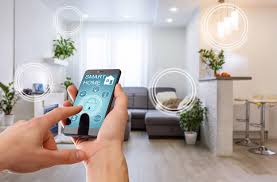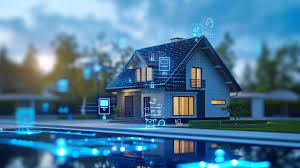Home Smart Tech Reviews
Smart Home Technology
The rise of smart home technology has transformed the way we interact with our living spaces. From controlling lights with a voice command to monitoring home security from a smartphone, smart devices offer convenience, efficiency, and peace of mind. In this comprehensive review, we explore the latest smart home devices, their features, and how they can enhance your daily life. Whether you’re a tech enthusiast or a homeowner looking to modernize, this guide will help you navigate the world of home smart tech.
Smart home devices connect to the internet, allowing users to control them remotely or automate tasks. These devices range from smart speakers and thermostats to security cameras and doorbells. The integration of artificial intelligence (AI) and the Internet of Things (IoT) has made these devices smarter, enabling seamless communication between gadgets. In 2025, the smart home market continues to grow, with innovations that cater to various needs and budgets.
Top Smart Home Devices of 2025
1. Smart Speakers: The Hub of Your Smart Home
Smart speakers, such as the Amazon Echo and Google Nest Audio, serve as the central hub for many smart homes. These devices use voice assistants like Alexa or Google Assistant to control other smart devices, play music, answer questions, and even manage your schedule. The latest models in 2025 feature improved sound quality, faster processing, and enhanced privacy controls.
Review: The Amazon Echo (5th Gen) offers crisp audio and a sleek design, making it a great addition to any room. Its integration with Alexa allows for seamless control of compatible devices, from lights to thermostats. However, some users may find the Google Nest Audio better for Google ecosystem integration.
When choosing a smart speaker, consider compatibility with your existing devices and preferred voice assistant. Both Amazon and Google offer robust ecosystems, but Apple’s HomePod Mini is a strong contender for Apple users, with Siri integration and high-quality audio for its size.
2. Smart Thermostats: Energy Efficiency Meets Comfort
Smart thermostats, like the Nest Learning Thermostat and Ecobee SmartThermostat, optimize home heating and cooling. These devices learn your schedule, adjust temperatures automatically, and can be controlled remotely via smartphone apps. Energy savings are a key benefit, with some models reducing energy bills by up to 15%.
Review: The Nest Learning Thermostat (4th Gen) stands out for its intuitive interface and ability to adapt to your routine within days. The Ecobee SmartThermostat, with its included remote sensor, excels in homes with uneven temperature zones, ensuring consistent comfort.
Installation is straightforward for most smart thermostats, though compatibility with your HVAC system is crucial. Check for features like geofencing, which adjusts settings based on your location, and integration with other smart home platforms.
3. Smart Lighting: Ambiance and Efficiency
Smart lighting systems, such as Philips Hue and LIFX, allow you to customize lighting colors, brightness, and schedules. These bulbs can be controlled via apps, voice commands, or automation routines, creating the perfect ambiance for any occasion. Energy-efficient LED technology ensures long-lasting performance.
Review: Philips Hue remains the gold standard for smart lighting, offering a wide range of bulbs, strips, and fixtures. Its app is user-friendly, and integration with Alexa, Google Assistant, and Apple HomeKit is seamless. LIFX bulbs, however, don’t require a hub, making them a cost-effective choice for smaller setups.
Smart lighting is ideal for enhancing home security by simulating occupancy when you’re away. Look for bulbs with high lumens for bright spaces and consider starter kits for easy setup.
4. Smart Security Systems: Peace of Mind
Home security has evolved with smart cameras, doorbells, and locks. Brands like Ring, Arlo, and Blink offer devices with features like 4K video, motion detection, and two-way audio. Smart doorbells, such as the Ring Video Doorbell Pro 2, provide real-time alerts and video feeds, while smart locks like August Wi-Fi Smart Lock allow keyless entry.
Review: The Arlo Ultra 2 delivers stunning 4K video and a wide field of view, making it ideal for monitoring large areas. The Ring Video Doorbell Pro 2 excels in user-friendly installation and integration with Alexa, though a subscription is required for video storage.
When choosing a security system, prioritize devices with local storage options or affordable cloud plans. Ensure compatibility with your Wi-Fi network and consider battery-powered options for flexibility.
Benefits of Smart Home Technology
Smart home devices offer numerous advantages, including convenience, energy savings, and enhanced security. By automating routine tasks, such as turning off lights or adjusting the thermostat, these devices save time and reduce energy consumption. Security systems provide real-time monitoring, deterring potential intruders and offering peace of mind.
Interconnectivity is a major strength of smart home tech. Devices from different brands can often work together through platforms like Amazon Alexa, Google Home, or Apple HomeKit. This allows for complex automation routines, such as dimming lights and locking doors when you say, “Good night.”
Accessibility is another benefit. Many devices are designed with user-friendly interfaces, and voice control makes them accessible to people of all ages and abilities. In 2025, manufacturers are also focusing on sustainability, with eco-friendly materials and energy-efficient designs.
Challenges and Considerations
Despite their benefits, smart home devices come with challenges. Compatibility issues can arise when mixing brands, so it’s essential to choose devices that support common protocols like Zigbee or Z-Wave. Privacy is another concern, as devices with cameras or microphones may collect data. Look for brands with transparent privacy policies and opt for devices with physical privacy shutters or mute buttons.
Cost is a factor, as smart home setups can be expensive, especially with subscription services for cloud storage or advanced features. However, starter kits and budget-friendly options from brands like Wyze make smart tech more accessible. Finally, ensure your Wi-Fi network is robust, as smart devices rely on stable internet connections.
Future of Smart Home Technology
The smart home industry is evolving rapidly. In 2025, we’re seeing advancements in AI-driven automation, with devices predicting user needs more accurately. For example, smart thermostats now integrate weather forecasts to optimize energy use. Matter, a universal smart home standard, is gaining traction, promising better interoperability between devices.
Sustainability is a growing focus, with manufacturers developing solar-powered cameras and recyclable materials. Health-focused smart devices, such as air quality monitors and sleep trackers, are also emerging, helping users create healthier living environments.
Trend to Watch: Matter-compatible devices are set to dominate, reducing compatibility issues and simplifying setups. Brands adopting this standard, like Philips Hue and Google Nest, are worth considering for future-proofing your smart home.
Conclusion
Smart home technology offers transformative benefits, from energy savings to enhanced security and convenience. By choosing devices that align with your needs and budget, you can create a connected, efficient, and secure home. Start with a smart speaker or thermostat to build your ecosystem, and expand with lighting, security, or specialized devices as needed.
As the industry evolves, staying informed about new products and standards like Matter will help you make smart choices. With the right setup, your home can become a hub of innovation, making daily life easier and more enjoyable. Explore the devices reviewed here, and take the first step toward a smarter home today.






